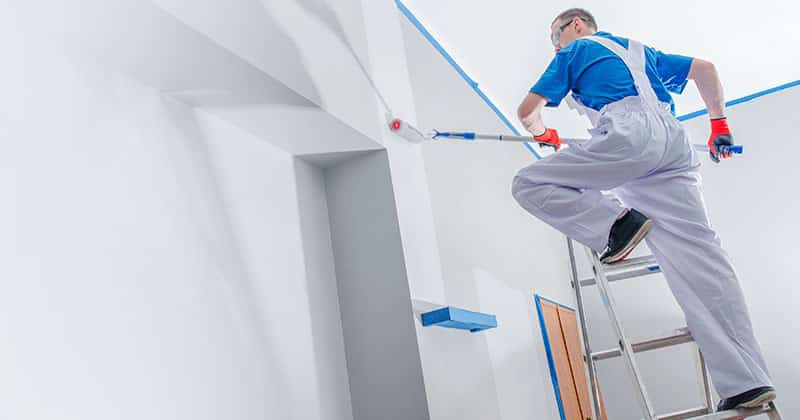
Starting a painting business can be a great way to turn your talent or passion into a lucrative venture. If you know your way around a paintbrush, why not trade those skills under your own brand?
You can’t go wrong with a painting business. Painting is a stable economic industry in the US worth $42.7 billion. And according to the US Bureau of Labor Statistics, the demand for painters holds at a steady 4%, with about 28,000 openings for painters projected each year over the next decade. Painting will remain an in-demand profession as long as people keep building and renovating homes.
This demand means a rewarding career as well. With an average annual wage of $48,660, painting turns a decent income. But, of course, you can earn a lot more as your own boss. A small painting startup should be able to do around $400,000–$600,000 worth of work annually and generate an income of $100,000 or more—says one entrepreneur.
Painting is an evolving industry too. There are countless new business opportunities in emerging trends, such as eco-friendly paints, nanocoating, and AI color design. Whether you’re an aspiring entrepreneur or an industry veteran, there’s something for you in the painting business.
To start a business, it takes more than just an entrepreneurial spirit. From paperwork and logistics to investments. You must also consider the potential opportunities and challenges of running the business. We discuss all that and more in this comprehensive guide on how to start a painting business. Read on and learn how to run a successful painting business from the ground up.
Business Planning
Starting any business begins with drawing up a solid business plan. A business plan is a detailed document describing the proposed business, its purpose, and its objectives. It serves as a blueprint for your business and a roadmap to achieving your business goals.
Sure, a business plan is important, but it doesn’t have to be overly complex or detailed. We’re not talking about coming up with a grand master plan to conquer the industry. For a small painting enterprise, especially, it can be a brief document only a few pages thick.
Just make sure it covers all the basic elements of business planning, including:
- Executive summary: This “intro” section provides a concise overview of the proposed business. In just a few words, it introduces the business by highlighting basic information about its goals (long-term and short-term), operations, location, etc.
- Business description: This section offers a more detailed description of the business. It includes specific details about the business structure, niche, value proposition, and strengths.
- Market analysis: You should have a good understanding of the painting market in your area. Describe the competitive landscape and how you hope to stand out among potential competitors. Also, identify your target customers and the marketing tactics you hope will work on them.
- Service line: Define your service offering. Will you be a commercial, residential, or niche painter?
- Operations plan: Explain how you’ll run the new painting business. Cover everything from crew management and service delivery to administration.
- Financial plan: This section should explain how you plan to fund the new venture and the resources needed in the first place. It should also give realistic revenue projections.
A good business plan erects guidelines that help you stay on track when starting or running a new venture. It also organizes things and gives you a big picture of what you’re about to do.
Setting Up Your Business
Step 2 is to get your new business registered. But first, you must choose a fitting business structure for your painting enterprise.
Choose the Right Business Structure
A business structure is the legal framework under which a business operates. It determines legal business aspects such as ownership, taxation, and liability. A limited liability company (LLC) happens to be the best structure for a small painting startup.
The main advantage of an LLC is that it separates your business assets from your personal assets. If the LLC incurs debts, lawsuits, or legal action, your personal assets remain safe. Corporations and partnerships offer this level of protection, too, but they can be tricky to set up. LLCs strike the perfect balance between simplicity and flexibility.
LLCs are registered at the state level. Depending on the state, this can be done through the Secretary of State’s office or an appointed business registerer.
There’s no harm in structuring your painting business as a sole proprietorship either. It’s actually way easier to set up and register than an LLC. However, you may be personally responsible for your business’s liabilities.
Get the Necessary Permits
In addition to registering the business, check with your local authorities about other regulatory requirements. These will depend on where your business will operate and the sort of jobs you’ll be doing.
In California, for example, you’ll need a C-33 license from the Contractors State Licensing Board (CSLB) for painting jobs valued over $500. There’s also EPA’s Lead Abatement Certification, which qualifies you to remove lead-based paint hazards in buildings.
The list goes on. So, check compliance requirements with contracting and regulatory bodies based on your service location and business model.
While at it, get your business insured. Take out sufficient general liability insurance to cover bodily injuries and property damage. You’ll also need workers’ compensation insurance if you plan to hire a painting crew.
Open a Business Bank Account
Next, open a dedicated bank account for your new business. While you could technically use your personal bank account for business, it’s not recommended.
As an entrepreneur, it’s always a good idea to keep business and personal funds separate. That’s one of the top tips for running a painting business. This makes it so much easier to track and manage business finances. It also simplifies tax calculations, reviews, and audits.
Additionally, business accounts come with extra perks and capabilities such as bulk transactions, discounted fees, robust security, and powerful management tools.
Choose a bank account that seamlessly integrates with your financial systems. For example, the account should support multiple payment methods and third-party bookkeeping tools.

Acquiring Equipment and Software
If you’re going to run a painting business, you’ll need various specialized tools and equipment. Your toolkit should include essential painting apparatus such as:
- Brushes
- Rollers and extension poles
- Paint trays
- Drop cloths
- Ladders
- Scaffolding
- Painter’s tape
- Scrapers
- Caulking gun
- Putty knife
- Sandpaper
- Paint sprayers
Shop around your local hardware stores for the best deals on quality painting equipment. Check out online stores as well. Online merchants like Ace Hardware, Sherwin-Williams, and Lowe’s have a wide selection of reasonably priced painting tools and supplies.
But that’s not all.
You’ll also need software tools to help you run the business. The days of crunching numbers on paper and spreadsheets are long gone. Modern business management tools can digitize nearly every aspect of your new business. Digitization makes the business more efficient, productive, and profitable.
Consider software tools like MarketSharp, Invoice Simple, Joist, and Service Fusion. These will help you manage scheduling, field operations, payments, billing and invoicing, client communications, and more.
Building Your Brand
Your new painting business will need an identity. That identity comes in the form of branding.
Branding is a way to make your business stand out. If done right, it should make your business recognizable and relatable to its target market. A strong brand helps you connect with customers, fostering trust and loyalty.
Here’s how to go about branding a painting startup:
- Choose a memorable name
Pick or coin a catchy and memorable name for your painting business. Brainstorm names that reflect your business or niche. It could be an acronym, clever wordplay, foreign word, or mashup.
Work that name into other branding assets such as the logo, slogan, and mission statement.
- Create your value proposition
What sets your business apart from other painters? You’ve got to have that unique selling point (USP)—that differentiates your brand from competitors. It could be your reasonably low prices, high-quality work, quick turnaround, or unique expertise.
Identify your value proposition and make it part of your brand identity. You can do that by openly communicating your USP.
- Define your brand’s personality
Brands, just like people, exhibit a personality. That personality is the sum of intangible characteristics that shape people’s perceptions of your business.
A brand’s personality is built on an emotional level. It’s what people feel about your brand. You want people to look at your painting brand and see trust, competence, artistry, and confidence.
Building a brand personality takes time. It mainly comes down to how you communicate and connect with customers. What matters are the qualities you portray in every word you say or every project you take.
- Tell your brand story
Storytelling is a big part of branding. Tell a story that brings your brand to life through narratives that resonate with your audience on a human level.
For example, tell stories about how the brand came to be. Also, build narratives around your work from the customer’s perspective. Focus on relatable stories that connect with your audience emotionally, bringing out the human side of your business.
Marketing
Marketing is an essential part of starting and running a painting business, and indeed any business. It’s a continuous multifaceted effort aimed at:
- Spreading brand awareness
- Generating painting leads
- Communicating your USP
- Promoting your painting services
- Scoring painting jobs
Let’s take a look at proven marketing strategies for painting contractors.
Search Engine Marketing
Approximately 68% of all website traffic comes from search engines. Google alone is responsible for nearly two-thirds of all referral web traffic in the US.
That means that most online user experiences start with a search engine query. And that’s where search engine marketing comes in. You can quickly present your brand to countless internet users through search engine optimization (SEO) or paid ads.
Follow these steps to get started on search engine marketing:
- Create and launch a branded website for your painting business.
- Populate the website with content relevant to your market, local area, and suite of services.
- Incorporate the right keywords into your web content.
- Mention your contact information and location throughout the website.
- Fill out your Google Business Profile.
- Encourage customers to write reviews on your site and Google page.
- Consider paid Google ads.
Social Media Marketing
Social media is a marketing powerhouse. In addition to having a large audience (over 250 million strong in the US), social media platforms give you powerful tools to target and engage narrow segments of users.
Create business profiles on all the big social platforms—Facebook, Twitter, Instagram, Pinterest, LinkedIn, and Nextdoor. Then, it’s only a matter of gathering and engaging followers. You can do this organically or by paying to promote your social content and profiles.
Email Marketing
Email marketing is a bit more direct and impactful. It starts with collecting email contacts of potential and existing customers. You then segment the emails depending on the type of contact. From there, you can send personalized promotional messages to each contact.
Emailing is a great way to generate and nurture leads, drive sales, and build customer loyalty.
Referral Marketing
Word-of-mouth marketing is hands down the most effective form of marketing. It’s where your own customers recommend your painting brand to others.
A referral program is one of the best ways to drive word-of-mouth. It’s an effective marketing strategy where you incentivize customers to refer other customers. The incentive could be something like a discount, exclusive service, or other perk.
You can also leverage customer feedback to drive referrals. Research shows that 42% of customers trust online reviews as much as personal recommendations. Reviews, testimonials, and case studies build social proof, encouraging new clients.

Attracting Customers
Every business needs a steady flow of customers to flourish. Below are practical tips to draw in new clients and keep them coming back:
- Identify your target audience and tailor your painting services to meet their needs.
- Double down on local advertising—handing out flyers, putting up posters, branding your vehicles and gear, etc.
- Participate in local community events such as sports, charity drives, and volunteer work.
- Partner or collaborate strategically with local businesses such as paint suppliers, real estate agencies, and builders in your area.
- Organize memorable social events such as fairs, cookouts, and competitions.
- Set up word-of-mouth triggers like low prices, excellent customer experience, seasonal discounts, etc.
- Make it easy for customers to find and hire you.
- Stay in touch with past customers.
RELATED ARTICLE: How to Get Painting Contracts
Running Business Operations
Starting a business is one thing, and running it is another.
For a painting contractor, the main business operation is executing painting projects. That sounds easy enough; just break out the brushes and get painting. Well, not quite. Painting as a business is far more involved than that.
Here’s a seven-step guide to running a profitable painting project.
Step 1: Evaluate the Client’s Request
The first thing you should do before taking on any project is to assess the job. Understand the scope of the job and the client’s expectations. That way, you’ll know what’s needed to complete the project.
The best way to evaluate a job offer is to arrange a site visit. If a visit won’t be possible, look at photos or videos of the site. The client can also describe the job via phone or email.
Step 2: Serve the Initial Quote
Once you’ve assessed the job, you should have a good idea of how much it’ll cost. The initial quote should be an estimated sum of materials and labor costs. Plus, of course, a markup as your profit.
The quote doesn’t have to be detailed or pinpoint accurate. The client just wants a rough idea of how much the paint job will cost.
Step 3: Draft a Contract
If the client is okay with the quote, you can move on to writing a contract. A painting contract is just a concise document describing the project and its particulars. It should highlight the project’s scope, time frame, cost, and expected outcomes.
Step 4: Start Work
With the green light from the client, you can start painting. At this point, you can organize a competent crew if you need one. Then, get all the supplies and tools required for the job and get cracking.
Step 5: Document Progress
Be sure to document everything as you proceed. For example, take before-and-after photos when applying a coat of paint or prepping the surface. Take pictures of the supplies and crew, too, as they work.
Crucially, keep receipts, invoices, work logs, and any other documents associated with the project.
Documentation is essential for tracking progress. And if there’s ever a dispute, you can always prove your case with tangible evidence.
Step 6: Bill the Client
After completing the project, give the client some time to review the work. Only when you get a thumbs-up from the client can you draw up that invoice.
Ensure the bill is accurate to the last cent. Also, leverage a robust payment system to make it easier for customers to settle invoices.
Step 7: Follow Up
A contract may end after getting paid, but not your relationship with the client. Get in touch after a while to see how the new paint job is holding up. Such conversations show that you value customer satisfaction and present opportunities for more jobs.
Streamline project management with MarketSharp’s Construction PM Software. Forget tedious manual processes; let this cutting-edge software track, optimize, and automate your workflows from start to finish.
Managing Finances
Up to 90% of startups fail; some don’t even make it past one year. Those are scary statistics, but don’t let them dampen your spirit.
Why do so many new businesses fail?
It turns out that cash flow problems are the number one reason for business failure. Many businesses simply run out of juice to keep going. Money issues can stem from any number of reasons, including poor financial management, unrealistic projections, and unchecked spending.
Follow these finance best practices to secure your spot in the successful 10% of startups:
- Calculate startup costs accurately.
- Ensure you have enough funds before getting started.
- Understand your business’s cash flow, ideally using a comprehensive analytics and reporting software.
- Make realistic revenue projections.
- Price your services and projects carefully to maintain profitability.
- Keep expenditure as low as possible.
- Track and review your business expenses closely.
- Keep an emergency fund.
- Take financing if you have to and manage debts wisely.
- Encourage your clients to pay on time.
- Avoid taking money out of the business before reaching a steady income.

Growing the Business
How far do you want to take your painting business? You should have an optimistic answer to this question before even launching the venture.
You’d obviously want the business to grow. In time, you could expand to more locations, hire a larger crew, handle more painting jobs, and so on.
Here are some handy tips you should keep in mind when thinking about growth:
- Diversify your services portfolio.
- Keep up with trends in the painting industry and home improvement space.
- Scale, train, and diversify your team as the business grows.
- Explore expansion opportunities in partnerships with other contractors.
- Keep learning new painting skills, ideas, and concepts.
- Don’t be too eager or aggressive; let the business grow organically and sustainably.
Solving Common Challenges
Starting and running a painting business is not without its challenges. But don’t worry, we’ve got that covered too. We’ve compiled a list of obstacles you might face and how to overcome them.
- Running out of cash: Don’t be afraid to explore alternative sources of funds. You could, for example, take out a business loan, bring in an investor, or seek financial support from friends and family.
- Slow seasons: The painting business will sometimes go into a bit of a slump. At such times, keep the business afloat by diversifying your offering. Open new income streams by taking on new kinds of jobs, clients, or markets.
- Difficult clients: Some clients are outrightly difficult to work with. Unfortunately, there’s not much you can do about someone’s character. Just try your best to communicate calmly and sensibly to disgruntled clients.
- Bad reviews: Respond to all reviews, both good and bad. A simple response can turn a bad review into a positive experience.
- Maintaining quality work: Do not compromise your quality of work in the name of cost saving. Build a reputation around high-quality paint jobs. In time, that reputation will pay for itself.
- Fierce competition: Stay one step ahead of competitors by offering something unique and valuable. Set yourself apart by filling a vacant niche, bringing a unique experience, or solving a pressing problem. And make that differentiation obvious to your customers.
Start Your Painting Business Today with MarketSharp
Starting your own painting business is an exciting opportunity—but success takes more than just a steady hand and a vision. From scheduling and job tracking to client management and invoicing, staying organized is key. That’s where MarketSharp can help.
MarketSharp’s all-in-one CRM software is built specifically for contractors like you. With intuitive tools to manage leads, automate workflows, and keep projects on track, MarketSharp takes the guesswork out of growing your painting business.
Ready to get started? Book a free, live demo of MarketSharp and see how it can streamline your operations and accelerate your path to success.

